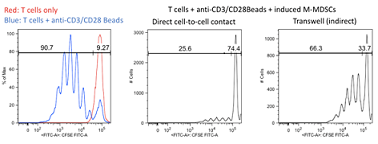The Phenotypic and Functional Characteristics of a Novel CD11b+CD11c+F4/80+ Monocytic Myeloid-Derived Suppressor Cell Subset.
1Center for Transplantation Sciences, Massachusetts General Hospital, Boston
2Dept. of Cardiac Surgery, Second Xiangya Hospital, Central South University, Changsha, China
Meeting: 2017 American Transplant Congress
Abstract number: 385
Keywords: Immunosuppression, Mononuclear leukocytes
Session Information
Session Name: Concurrent Session: Regulatory Cells in Alloimmunity
Session Type: Concurrent Session
Date: Monday, May 1, 2017
Session Time: 4:30pm-6:00pm
 Presentation Time: 5:30pm-5:42pm
Presentation Time: 5:30pm-5:42pm
Location: E352
Background: CD11b+Ly6G–Ly6Chigh monocytic myeloid-derived suppressor cells (M-MDSCs) in mice can promote the apoptosis of T cells and induce regulatory T cells. Novel CD11b+CD11c+F4/80+ cells were previously reported and described as adipose tissue macrophages and renal mononuclear phagocytes, but not as an MDSC subset. The phenotypic and functional characteristics of CD11b+CD11c+F4/80+ as M-MDSCs remain unclear.
Aim: This study investigates the phenotype and immunosuppressive capability of murine CD11b+CD11c+F4/80+ M-MDSCs in vitro and in vivo.
Methods: CD11b+Ly6G–Ly6Chigh cells were isolated from the bone marrow of naïve BL/6 mice by negative selection and cultured with M-CSF, IL-4, TNF-a, and activated by lipopolysaccharide. The ability of M-MDSCs from WT mice, IL10 and NOS2 knockout (KO) mice to suppress CFSE-labeled T cells was assessed in vitro using a proliferation assay. For in vivo studies, we adoptively transferred syngeneic induced M-MDSCs to BL/6 recipients of DBA/2 heart allografts. The peripheral blood, spleen and graft were analyzed by flow cytometry and immunohistochemistry.
Result: Induced M-MDSCs showed a CD11b+CD11c+F4/80+Ly6C+ phenotype, also expressed iNOS, arginase, IDO, PD-L1, podoplanin, DC-SIGN, and they inhibited CD4+ T cell and CD8+ T cell proliferation both directly (cell-to-cell contact) and indirectly (transwell). Induced M-MDSCs from iNOS and IL-10 KO mice inhibited T cell proliferation as well as induced M-MDSCs from WT mice. Adoptive transfer of induced M-MDSCs resulted in increased CD4+Foxp3+ regulatory T cells in peripheral blood (15.7% vs 9.58%) and spleen (17.1% vs 9.85%) of treated vs untreated animals, respectively. We are currently pursuing the effect of these cells on allograft survival.
Induced M-MDSCs from iNOS and IL-10 KO mice inhibited T cell proliferation as well as induced M-MDSCs from WT mice. Adoptive transfer of induced M-MDSCs resulted in increased CD4+Foxp3+ regulatory T cells in peripheral blood (15.7% vs 9.58%) and spleen (17.1% vs 9.85%) of treated vs untreated animals, respectively. We are currently pursuing the effect of these cells on allograft survival.
Conclusion: The CD11b+CD11c+F4/80+ M-MDSCs displayed a unique phenotype which is different from classical M1/M2 macrophages. These cells inhibited T cell proliferation in vitro and induced regulatory T cells in vivo.
CITATION INFORMATION: Jiang B, Aljabban I, Yang C, Ndishabandi D, White R, Russell P, Madsen J, Colvin R, Alessandrini A. The Phenotypic and Functional Characteristics of a Novel CD11b+CD11c+F4/80+ Monocytic Myeloid-Derived Suppressor Cell Subset. Am J Transplant. 2017;17 (suppl 3).
To cite this abstract in AMA style:
Jiang B, Aljabban I, Yang C, Ndishabandi D, White R, Russell P, Madsen J, Colvin R, Alessandrini A. The Phenotypic and Functional Characteristics of a Novel CD11b+CD11c+F4/80+ Monocytic Myeloid-Derived Suppressor Cell Subset. [abstract]. Am J Transplant. 2017; 17 (suppl 3). https://atcmeetingabstracts.com/abstract/the-phenotypic-and-functional-characteristics-of-a-novel-cd11bcd11cf480-monocytic-myeloid-derived-suppressor-cell-subset/. Accessed January 1, 2026.« Back to 2017 American Transplant Congress
